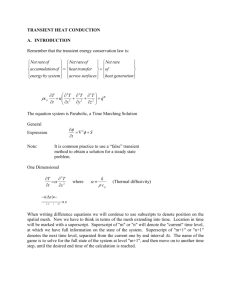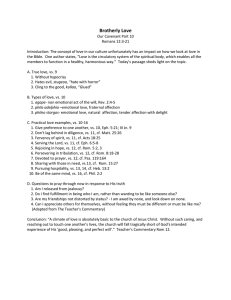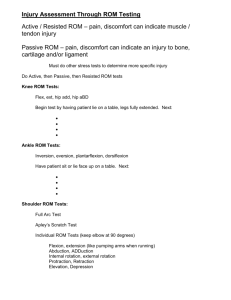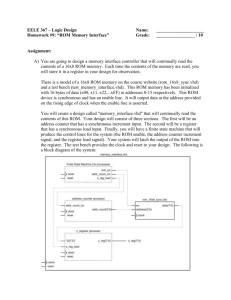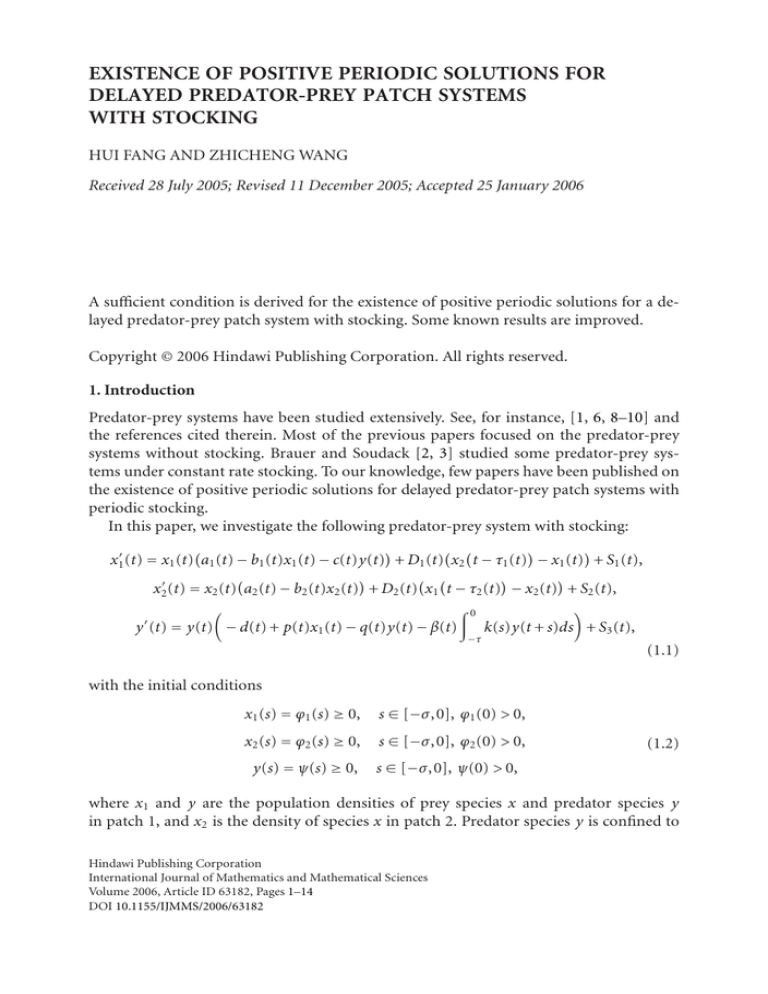
EXISTENCE OF POSITIVE PERIODIC SOLUTIONS FOR
DELAYED PREDATOR-PREY PATCH SYSTEMS
WITH STOCKING
HUI FANG AND ZHICHENG WANG
Received 28 July 2005; Revised 11 December 2005; Accepted 25 January 2006
A sufficient condition is derived for the existence of positive periodic solutions for a delayed predator-prey patch system with stocking. Some known results are improved.
Copyright © 2006 Hindawi Publishing Corporation. All rights reserved.
1. Introduction
Predator-prey systems have been studied extensively. See, for instance, [1, 6, 8–10] and
the references cited therein. Most of the previous papers focused on the predator-prey
systems without stocking. Brauer and Soudack [2, 3] studied some predator-prey systems under constant rate stocking. To our knowledge, few papers have been published on
the existence of positive periodic solutions for delayed predator-prey patch systems with
periodic stocking.
In this paper, we investigate the following predator-prey system with stocking:
x1 (t) = x1 (t) a1 (t) − b1 (t)x1 (t) − c(t)y(t) + D1 (t) x2 t − τ1 (t) − x1 (t) + S1 (t),
x2 (t) = x2 (t) a2 (t) − b2 (t)x2 (t) + D2 (t) x1 t − τ2 (t) − x2 (t) + S2 (t),
y (t) = y(t) − d(t) + p(t)x1 (t) − q(t)y(t) − β(t)
0
−τ
k(s)y(t + s)ds + S3 (t),
(1.1)
with the initial conditions
x1 (s) = ϕ1 (s) ≥ 0,
s ∈ [−σ,0], ϕ1 (0) > 0,
x2 (s) = ϕ2 (s) ≥ 0,
s ∈ [−σ,0], ϕ2 (0) > 0,
y(s) = ψ(s) ≥ 0,
(1.2)
s ∈ [−σ,0], ψ(0) > 0,
where x1 and y are the population densities of prey species x and predator species y
in patch 1, and x2 is the density of species x in patch 2. Predator species y is confined to
Hindawi Publishing Corporation
International Journal of Mathematics and Mathematical Sciences
Volume 2006, Article ID 63182, Pages 1–14
DOI 10.1155/IJMMS/2006/63182
2
Periodic solutions for predator-prey patch systems
patch 1, while the prey species x can diffuse between two patches. Di (t) (i = 1,2) are diffusion coefficients of species x. Si (t) (i = 1,2,3) denote the stocking rates. ϕ1 (s), ϕ2 (s), and
ψ(s) are continuous on [−σ,0], σ = max{τ,supt∈R τ1 (t),supt∈R τ2 (t)}. The delay τ1 (τ2 )
represents the time that species x migrates from patch 2 to patch 1 (patch 1 to patch 2).
When Si (t) ≡ 0 (i = 1,2,3), τi ≡ 0 (i = 1,2), system (1.1) was considered by Zhang and
Wang [15], Song and Chen [11], and Chen et al. [5].
The purpose of this paper is to derive a set of easily verifiable conditions for the existence of positive periodic solutions of system (1.1). The method in this paper is different
from those of [4, 12–14].
2. Existence of positive periodic solutions
To show the existence of solutions to the considered problems, we will use an abstract
theorem developed [7]. We first state this abstract theorem.
For a fixed σ ≥ 0, let C := C([−σ,0]; Rn ). If x ∈ C([γ − σ,γ + δ]; Rn ) for some δ > 0
and γ ∈ R, then xt ∈ C for t ∈ [γ,γ + δ] is defined by xt (θ) = x(t + θ) for θ ∈ [−σ,0]. The
is, φc = maxθ∈[−σ,0] φ(θ) for φ ∈ C,
supremum norm in C is denoted by · c , that
n
where · denotes the norm in R , and u = ni=1 |ui | for u = (u1 ,...,un ) ∈ Rn .
We consider the following functional differential equation:
dx(t)
= f t,xt ,
dt
(2.1)
where f : R × C → Rn is completely continuous, and there exists T > 0 such that for every
(t,ϕ) ∈ R × C, we have f (t + T,ϕ) = f (t,ϕ).
The following lemma is a simple consequence of [7, Theorem 4.7.1].
Lemma 2.1. Suppose that there exists a constant M > 0 such that
(i) for any λ ∈ (0,1) and any T-periodic solution x of the system
dx(t)
= λ f t,xt ,
dt
(2.2)
x(t) < M for t ∈ R;
T
(ii) g(u) := (1/T) 0 f (s, u)ds = 0 for u ∈ ∂BM (Rn ), where BM (Rn ) = {u ∈ Rn : u <
M }, and u denotes the constant mapping from [−σ,0] to Rn with the value u ∈ Rn ;
(iii) Brouwer degree deg(g,BM (Rn )) = 0.
Then there exists at least one T-periodic solution of the system
dx(t)
= f t,xt
dt
(2.3)
that satisfies supt∈R x(t) < M.
In the following, we set
ḡ =
1
T
T
0
g(t)dt,
g l = min g(t)
,
t ∈[0,T]
where g is a continuous T-periodic function.
g u = max g(t)
,
t ∈[0,T]
(2.4)
H. Fang and Z. Wang 3
In system (1.1), we always assume the following.
(H1 ) ai (t), bi (t), Di (t) (i = 1,2), c(t), d(t), p(t), q(t), and β(t) are positive continuous
T-periodic functions. Si (t) (i = 1,2,3), τi (t) (i = 1,2) are nonnegative continuous
T-periodic functions. τi (t) < 1 (i = 1,2), t ∈ R.
(H2 ) k(s) ≥ 0 on [−τ,0] (0 ≤ τ < +∞); and k(s) is a piecewise continuous and normal0
ized function such that −τ k(s)ds = 1.
Set
K=
q̄ + β̄
,
p̄
a M − D1 M0 + S1 l
K = 1 0
,
b1 M0
∗
M0 = max
l
m0 = min
u
0 =
M
u a2 + a22 + 4b2 S2
,
2b2
0
exp − 2T D̄1 + b̄1 M0 + c̄M
m
0 = min
a M +S l
Ki = i 0 i ,
bi M0
a1 + a21 + 4b1 S1
2b1
a1 /c − S3 /q
b1u /cl + (p/q)u
∗
pM0 + p2 M02 + 4qS3
2q
i = 1,2,
u ,
a2 + a22 + 4b2 S2
,
2b2
l ,
u
,
¯ p̄ K2∗ − d/
¯ p̄ K ∗ − d/
¯ p̄
K1∗ − d/
0 + β̄M
0 .
u ,
u exp − 2T d¯ + q̄M
,
K
K + c/b1
K + c/b1
(2.5)
Theorem 2.2. In addition to (H1 ), (H2 ), assume further that system (1.1) satisfies one of
the following assumptions:
¯ p̄ (i = 1,2);
(H3 ) (a1 /c)l > (S3 /q)u , Ki∗ > d/
¯ p̄.
(H4 ) (a1 /c)l > (S3 /q)u , K ∗ > d/
Then system (1.1) has at least one positive T-periodic solution, say (x1∗ (t),x2∗ (t), y ∗ (t))T
such that
m0 ≤ xi∗ (t) ≤ M0
(i = 1,2),
0 ,
m
0 ≤ y ∗ (t) ≤ M
t ≥ 0.
(2.6)
Proof. Consider the following system:
u1 (t) = a1 (t) − D1 (t) − b1 (t)eu1 (t) − c(t)eu3 (t) + D1 (t)eu2 (t−τ1 (t))−u1 (t) +
u2 (t) = a2 (t) − D2 (t) − b2 (t)eu2 (t) + D2 (t)eu1 (t−τ2 (t))−u2 (t) +
u3 (t) = −d(t) + p(t)eu1 (t) − q(t)eu3 (t) − β(t)
0
−τ
S1 (t)
,
eu1 (t)
S2 (t)
,
eu2 (t)
k(s)eu3 (t+s) ds +
S3 (t)
,
eu3 (t)
(2.7)
4
Periodic solutions for predator-prey patch systems
where ai (t), bi (t), Di (t) (i = 1,2), Si (t) (i = 1,2,3), c(t), d(t), p(t), q(t), and β(t) are the
same as those in assumption (H1 ), and τ, τi (i = 1,2) and k(s) are the same as those in
assumption (H2 ). We first show that system (2.7) has one T-periodic solution.
Let C := C([−σ,0]; R3 ). We define the following map:
f : R × C −→ R3 ,
f (t,ϕ) = f1 (t,ϕ), f2 (t,ϕ), f3 (t,ϕ) ,
ϕ = ϕ1 ,ϕ2 ,ϕ3 ∈ C,
f1 (t,ϕ) = a1 (t) − D1 (t) − b1 (t)eϕ1 (0) − c(t)eϕ3 (0) + D1 (t)eϕ2 (−τ1 (t))−ϕ1 (0) +
f2 (t,ϕ) = a2 (t) − D2 (t) − b2 (t)eϕ2 (0) + D2 (t)eϕ1 (−τ2 (t))−ϕ2 (0) +
f3 (t,ϕ) = −d(t) + p(t)eϕ1 (0) − q(t)eϕ3 (0) − β(t)
0
−τ
S1 (t)
,
eϕ1 (0)
(2.8)
S2 (t)
,
eϕ2 (0)
k(s)eϕ3 (s) ds +
S3 (t)
.
eϕ3 (0)
Clearly, f : R × C → R3 is completely continuous. Now, the system (2.7) becomes
du(t)
= f t,ut .
dt
(2.9)
Corresponding to
du(t)
= λ f t,ut ,
dt
λ ∈ (0,1),
(2.10)
we have
u1 (t) = λ a1 (t) − D1 (t) − b1 (t)eu1 (t) − c(t)eu3 (t) + D1 (t)eu2 (t−τ1 (t))−u1 (t) +
u2 (t) = λ a2 (t) − D2 (t) − b2 (t)eu2 (t) + D2 (t)eu1 (t−τ2 (t))−u2 (t) +
u3 (t) = λ − d(t) + p(t)eu1 (t) − q(t)eu3 (t) − β(t)
0
−τ
S1 (t)
,
eu1 (t)
S2 (t)
,
eu2 (t)
k(s)eu3 (t+s) ds +
S3 (t)
.
eu3 (t)
(2.11)
Suppose that (u1 (t),u2 (t),u3 (t))T is a T-periodic solution of system (2.11) for some λ ∈
(0,1). Choose tiM ,tim ∈ [0,T], i = 1,2,3, such that
ui tiM = max ui (t),
t ∈[0,T]
ui tim = min ui (t),
t ∈[0,T]
i = 1,2,3.
(2.12)
Then, it is clear that
ui tiM = 0,
ui tim = 0,
i = 1,2,3.
(2.13)
H. Fang and Z. Wang 5
From this and system (2.11), we obtain that
a1 t1M
− D1 t1M
− b1 t1M
u1 (t1M )
e
−c
t1M
e
u3 (t1M )
M
+D1 t1M
e
u2 (t1M −τ1 (t1M ))−u1 (t1M )
M
M
M
a2 t2M − D2 t2M − b2 t2M eu2 (t2 ) + D2 t2M eu1 (t2 −τ2 (t2 ))−u2 (t2 ) +
M
M
−d t3M + p t3M eu1 (t3 ) − q t3M eu3 (t3 ) − β t3M
m
0
−τ
m
S2 t2M
= 0,
M
eu2 (t2 )
M
k(s)eu3 (t3 +s) ds +
m
m
m
a1 t1m − D1 t1m − b1 t1m eu1 (t1 ) − c t1m eu3 (t1 ) +D1 t1m eu2 (t1 −τ1 (t1 ))−u1 (t1 ) +
m
m
m
(2.16)
m
S1 t1
m = 0,
eu1 (t1 )
(2.17)
S2 t2m
= 0.
m
eu2 (t2 )
m
a2 t2m − D2 t2m − b2 t2m eu2 (t2 ) + D2 t2m eu1 (t2 −τ2 (t2 ))−u2 (t2 ) +
(2.15)
S3 t3M
= 0,
M
eu3 (t3 )
S1 t M
+ u (t1M ) = 0,
e1 1
(2.14)
(2.18)
Next we make the following claims.
Claim 1. For ui (tiM ) (i = 1,2), one of the following cases holds:
u2 t2M ≤ u1 t1M ≤ M1∗ ≤ M1 ,
u1 t1M
< u2 t2M
(2.19)
∗
≤ M2 ≤ M1 ,
(2.20)
where M1 := max{M1∗ ,M2∗ }, M ∗j := ln((a j + a2j + 4b j S j )/2b j )u , j = 1,2.
There are two cases to consider.
Case 1. Assume that u1 (t1M ) ≥ u2 (t2M ); then u1 (t1M ) ≥ u2 (t1M − τ1 (t1M )).
From this and (2.14), we have
b1 t1M
e
u1 (t1M )
≤ a1 t1M
S1 t M
+ u (t1M ) .
e1 1
(2.21)
That is,
M
M
b1 t1M e2u1 (t1 ) − a1 t1M eu1 (t1 ) − S1 t1M ≤ 0.
(2.22)
Therefore,
e
u1 (t1M )
a1 t1M + a21 t1M + 4b1 t1M S1 t1M
a1 + a21 + 4b1 S1
M
≤
≤
2b1
2b1 t1
u
.
(2.23)
Hence,
M
u2 t2
M
≤ u1 t1
a1 + a21 + 4b1 S1
≤ ln
2b1
u
.
(2.24)
6
Periodic solutions for predator-prey patch systems
Case 2. Assume that u1 (t1M ) < u2 (t2M ); then u1 (t2M − τ2 (t2M )) < u2 (t2M ).
From this and (2.15), we have
b2 t2M
e
u2 (t2M )
≤ a2 t2M
S2 t M
+ u (t2M ) .
e2 2
(2.25)
By a similar argument to Case 1, we have
M
u1 t1
M
< u2 t2
a2 + a22 + 4b2 S2
≤ ln
2b2
u
.
(2.26)
It follows from (2.24) and (2.26) that Claim 1 holds.
Claim 2.
M
u3 t3
pM0 + p2 M02 + 4qS3
≤ ln
2q
u
:= M2 ,
(2.27)
where M0 = eM1 .
By (2.16), we have
M
M
q t3M eu3 (t3 ) ≤ p t3M eu1 (t3 ) +
S3 t3M
S3 t M
M
≤ p t3M eu1 (t1 ) + u (t3M ) .
M
u
(t
)
e3 3
e3 3
(2.28)
That is,
M
M
M
q t3M e2u3 (t3 ) − p t3M eu1 (t1 ) eu3 (t3 ) − S3 t3M ≤ 0.
Therefore,
e
u3 (t3M )
M
M
(2.29)
p t3M eu1 (t1 ) + p2 t3M e2u1 (t1 ) + 4q t3M S3 t3M
≤
,
2q t3M
(2.30)
which implies that Claim 2 holds.
Claim 3. For ui (tim )(i = 1,2), one of the following cases holds:
0 ≤ u1 t1m ≤ u2 t2m ,
m1 ≤ m∗1 − 2T D̄1 + b̄1 M0 + c̄M
m1 ≤ m∗2 ≤ u2 t2m < u1 t1m ,
(2.31)
where
0 ,m∗
m1 := min m∗1 − 2T D̄1 + b̄1 M0 + c̄M
2 ,
l
u
a1 /c − S3 /q
,
m∗1 := ln
b1u /cl + (p/q)u
a2 + a22 + 4b2 S2
m2 := ln
2b2
∗
There are two cases to consider.
(2.32)
l
.
H. Fang and Z. Wang 7
Case 1. Assume that u1 (t1m ) ≤ u2 (t2m ); then u1 (t1m ) ≤ u2 (t1m − τ1 (t1m )).
From this and (2.17), we have
m
m
M
M
a1 t1m ≤ b1 t1m eu1 (t1 ) + c t1m eu3 (t1 ) ≤ b1 t1m eu1 (t1 ) + c t1m eu3 (t3 ) .
(2.33)
From (2.30), by using the inequality
(a + b)1/2 < a1/2 + b1/2 ,
a > 0, b > 0,
(2.34)
we have
e
u3 (t3M )
M
p t3M eu1 (t1 ) + q t3M S3 t3M
<
.
q t3M
(2.35)
From this and (2.33), we have
a1 t1m
b1 t1m
≤
c tm p tM
+ 1 M 3
q t3
e
u1 (t1M )
+c
t1m
M
S3 t3 ,
q t3M
(2.36)
which implies
a1
c
l
u p
b1u
≤
+
l
c
q
e
u1 (t1M )
+
S u
3
q
.
(2.37)
That is,
M
u1 t1
l
a1 /c − S3 /q
≥ ln
b1u /cl + (p/q)u
u
:= m∗1 .
(2.38)
From the first equation of system (2.11), we obtain that
T
0
T
a1 (t)dt +
=
T
0
D1 (t)e
T
u (t)
dt <
1
0
T
D1 (t)dt +
0
T
0
u2 (t −τ1 (t))−u1 (t)
0
0
T
+
0
D1 (t)e
T
D1 (t)dt +
dt +
b1 (t)eu1 (t) dt +
T
a1 (t)dt +
T
0
T
0
0
S1 (t)
dt
eu1 (t)
c(t)eu3 (t) dt,
u2 (t −τ1 (t))−u1 (t)
b1 (t)eu1 (t) dt +
T
dt +
T
0
0
(2.39)
S1 (t)
dt
eu1 (t)
c(t)eu3 (t) dt.
8
Periodic solutions for predator-prey patch systems
It follows that
T
0
u (t)
dt < 2
T
T
1
≤2
D1 (t)dt +
0
T
0
0
b1 (t)eu1 (t) dt +
D1 (t)dt + eM1
T
0
T
c(t)eu3 (t) dt
0
b1 (t)dt + eM2
T
c(t)dt
0
(2.40)
0 .
= 2T D̄1 + b̄1 M0 + c̄M
From (2.38) and (2.40), we have
u1 t1m
≥ u1 t1M
−
T
0
u (t)
dt ≥ m∗ − 2T D̄1 + b̄1 M0 + c̄M
0 .
1
1
(2.41)
Case 2. Assume that u1 (t1m ) > u2 (t2m ); then u1 (t2m − τ2 (t2m )) > u2 (t2m ).
From this and (2.18), we have
m
b2 t2m eu2 (t2 ) ≥ a2 t2m +
S2 (t2m )
m ,
eu2 (t2 )
(2.42)
which implies
e
u2 (t2m )
a2 t2m + a22 t2m + 4b2 t2m S2 t2m
≥
.
2b2 t2m
(2.43)
That is,
a2 + a22 + 4b2 S2
u2 (t2m ) ≥ ln
2b2
l
:= m∗2 .
(2.44)
It follows from (2.41) and (2.44) that Claim 3 holds.
Claim 4.
0 + β̄M
0 := m2 ,
u3 t3m ≥ min m∗3 ,m∗4 ,m∗5 − 2T d¯ + q̄M
(2.45)
where
m∗3 = ln
¯ p̄
K1∗ − d/
u ,
K + c/b1
m∗4 = ln
¯ p̄
K2∗ − d/
,
K
m∗5 = ln
¯ p̄
K ∗ − d/
u .
K + c/b1
(2.46)
From the third equation of (2.11), we obtain
T
0
p(t)eu1 (t) dt +
T
0
T
0
S3 (t)
dt =
eu3 (t)
u (t)
dt <
3
T
0
T
0
T
d(t)dt +
0
p(t)eu1 (t) dt +
T
+
0
q(t)eu3 (t) dt +
T
0
S3 (t)
dt +
eu3 (t)
q(t)eu3 (t) dt +
T
0
T
0
−τ
k(s)eu3 (t+s) dsdt,
T
0
0
β(t)
0
β(t)
−τ
d(t)dt
k(s)eu3 (t+s) dsdt.
(2.47)
H. Fang and Z. Wang 9
It follows that
T
0
u (t)
dt < 2
T
T
3
≤2
d(t)dt +
0
T
0
0
T
q(t)eu3 (t) dt +
d(t)dt + eM2
T
0
0
β(t)
0
q(t)dt + eM2
−τ
k(s)eu3 (t+s) dsdt
T
0
(2.48)
β(t)dt
0 + β̄M
0 ,
= 2T d¯ + q̄M
M
q̄ + β̄ eu3 (t3 ) ≥ p̄eu1
t1m
¯
− d.
(2.49)
There are two cases to consider.
Case 1. Assume that the assumption (H3 ) holds.
If u1 (t1m ) ≤ u2 (t2m ), by (2.17), we have
e
u1 (t1m )
m
M
S1 t m
a1 t1m − c t1m eu3 (t1 )
m
≥
+ m 1u1 (tm )
b1 t1
b1 t1 e 1
(2.50)
S1 t m
a1 t1m − c t1m eu3 (t3 )
m
≥
+ m 1 M1 .
b1 t1
b1 t1 e
Substituting this into (2.49) gives
[q̄ + β̄]e
u3 (t3M )
M
p̄S1 t m
p̄a1 t1m
p̄c t1m eu3 (t3 )
¯
m −
m
≥
+ m 1 M1 − d,
b1 t1
b1 t1
b1 t1 e
(2.51)
which implies
q̄ β̄ c t1m
S1 t m
a1 t m
M
d¯
+ + m eu3 (t3 ) ≥ 1m + m 1 M1 − .
p̄ p̄ b1 t1
p̄
b1 t1
b1 t1 e
(2.52)
Therefore,
c
K+
b1
u M
d¯
eu3 (t3 ) ≥ K1∗ − .
p̄
(2.53)
¯ p̄
K1∗ − d/
u := m∗
3.
K + c/b1
(2.54)
That is,
u3 t3M ≥ ln
It follows from (2.48) and (2.54)that
u3 t3m ≥ u3 t3M −
T
0
u (t)
dt ≥ m∗ − 2T d¯ + q̄M
0 + β̄M
0 .
3
3
(2.55)
If u1 (t1m ) > u2 (t2m ), by (2.42), (2.49), and (2.19), we have
[q̄ + β̄]e
u3 (t3M )
≥ p̄e
u2 (t2m )
p̄ a2 t2m + S2 t2m e−M1
¯
− d¯ ≥
− d,
b2 t2m
(2.56)
10
Periodic solutions for predator-prey patch systems
which implies
q̄ β̄ u3 (t3M ) a2 t2m + S2 t2m e−M1 d¯
m
+
− .
e
≥
p̄ p̄
p̄
b2 t2
(2.57)
Therefore,
Keu3
t3M
≥ K2∗ −
d¯
.
p̄
(2.58)
That is,
¯ p̄
K2∗ − d/
:= m∗4 .
K
u3 t3M ≥ ln
(2.59)
From (2.48) and (2.59), we have
u3 t3m ≥ u3 t3M −
T
u (t)
dt ≥ m∗ − 2T d¯ + q̄M
0 + β̄M
0 .
3
0
4
(2.60)
Case 2. Assume that the assumption (H4 ) holds.
From (2.17), we have
b1 t1m
e
u1 (t1m )
m
≥ a1 t1m
m
− D1 t1m
−c
t1m
e
u3 (t1m )
S1 t m
+ u1 (t1m )
e 1
(2.61)
a1 t1m − D1 t1m − c t1m eu3 (t3 ) + S1 t1m e−M1
≥
.
b1 t1m
(2.62)
m
≥ a1 t1 − D1 t1 − c t1 e
u3 t3M
S1 t m
+ M11 .
e
Therefore,
e
u1 (t1m )
M
Substituting this into (2.49) gives
[q̄ + β̄]e
p̄ a1 t1m − D1 t1m
≥
b1 t1m
M
p̄c t1m eu3 t3
−
b1 t1m
p̄S1 t m
¯
+ m 1 M1 − d,
b1 t1 e
(2.63)
q̄ β̄ c t1m
a1 t1m − D1 t1m + S1 t1m e−M1 d¯
M
m
+ + m eu3 (t3 ) ≥
− .
p̄ p̄ b1 t1
p̄
b1 t1
(2.64)
u3 (t3M )
which implies
Therefore,
c
K+
b1
u M
d¯
eu3 (t3 ) ≥ K ∗ − .
p̄
(2.65)
¯ p̄
K ∗ − d/
u := m∗
5.
K + c/b1
(2.66)
That is,
u3 t3M ≥ ln
H. Fang and Z. Wang 11
It follows from(2.48) and (2.66)that
u3 t3m ≥ u3 t3M −
T
u (t)
dt ≥ m∗ − 2T d¯ + q̄M
0 + β̄M
0 .
3
0
5
(2.67)
It follows from (2.55), (2.60), and (2.67) that Claim 4 holds.
Clearly, one of the following inequalities holds:
(i) M1∗ > m∗2 ,
(ii) M1∗ ≤ m∗2 .
Since m∗1 < M1∗ and m∗2 ≤ M2∗ , (ii) implies M2∗ > m∗1 . Thus, according to Claims 1–3, one
of the following four cases must hold:
0 ) ≤ u1 (t1m ) ≤ u2 (t2m ), u2 (t2M ) ≤ u1 (t1M ) ≤ M1∗ ≤ M1 ;
(P1 ) m1 ≤ m∗1 − 2T(D̄1 + b̄1 M0 + c̄M
m
m
∗
(P2 ) m1 ≤ m2 ≤ u2 (t2 ) < u1 (t1 ), u2 (t2M ) ≤ u1 (t1M ) ≤ M1∗ ≤ M1 ;
0 ) ≤ u1 (t1m ) ≤ u2 (t2m ), u1 (t1M ) < u2 (t2M ) ≤ M2∗ ≤
(P3 ) m1 ≤ m∗1 − 2T(D̄1 + b̄1 M0 + c̄M
M1 ;
(P4 ) m1 ≤ m∗2 ≤ u2 (t2m ) < u1 (t1m ), u1 (t1M ) < u2 (t2M ) ≤ M2∗ ≤ M1 .
From this and Claims 3 and 4, we have
max ui (t)
≤ max M1 , M2 , m1 , m2 := M ∗ ,
t ∈[0,T]
i = 1,2,3.
(2.68)
Obviously, M ∗ is independent of λ.
Set
Bi∗ := āi +
2
āi
i = 1,2.
+ 4b̄i S̄i ,
(2.69)
Take sufficiently large M such that
M > 3max M ∗ , m∗1 , m∗2 , m∗3 , m∗4 , m∗5 ,
M > v1∗ + |v2∗ + v3∗ ,
(2.70)
where
v1∗ = ln
B1∗
,
2b̄1
v2∗ = ln
B2∗
,
2b̄2
2 p̄B1∗ + [ p̄B1∗ ]2 + 16 b̄1
v3∗ = ln
4b̄1 q̄ + β̄
(2.71)
q̄ + β̄ S̄3
.
Clearly, the condition (i) in Lemma 2.1 is satisfied by system (2.7).
Define H(u1 ,u2 ,u3 ,μ) : R3 × [0,1] → R3 by
⎛
⎜
⎜
⎜
H u1 ,u2 ,u3 ,μ = ⎜
⎜
⎜
⎝
⎞
S̄1
⎛
⎞
⎟
eu1
⎟
D̄1 eu2 −u1 − c̄eu3 − D̄1
⎟
⎟
S̄
⎟ + μ⎜
⎝ D̄2 eu1 −u2 − D̄2 ⎠ .
ā2 − b̄2 eu2 + u22
⎟
⎟
e
¯
−d
S̄ ⎠
p̄eu1 − [q̄ + β̄]eu3 + u33
e
ā1 − b̄1 eu1 +
(2.72)
12
Periodic solutions for predator-prey patch systems
We show that
H u1 ,u2 ,u3 ,μ = 0 for any u = u1 ,u2 ,u3 ∈ ∂BM R3 , μ ∈ [0,1].
(2.73)
Indeed, assume to the contrary, that
H u∗1 ,u∗2 ,u∗3 ,μ∗ = 0
for some u∗ = u∗1 ,u∗2 ,u∗3 ∈ ∂BM R3 , μ∗ ∈ [0,1].
(2.74)
Then, there exist ti ∈ [0,T], i = 1,2, such that
∗ ∗
∗
S1 t1
a1 t1 − b1 t1 e + u∗ + μ∗ D1 t1 eu2 −u1 − μ∗ c t1 eu3 − μ∗ D1 t1 = 0,
e1
∗ S2 t2
∗ ∗
a2 t2 − b2 t2 eu2 + u∗ + μ∗ D2 t2 eu1 −u2 − μ∗ D2 t2 = 0,
e2
∗ S̄3
∗
−μ∗ d¯ + p̄eu1 − q̄ + β̄ eu3 + u∗ = 0.
e3
u∗
1
(2.75)
By using the arguments of (2.19), (2.20), (2.27), (2.38), (2.44), (2.54), (2.59), (2.66), one
can prove that
∗
u ≤ max M1 , M2 , m∗ , m∗ , m∗ , m∗ , m∗ |,
i
1
2
3
4
5
i = 1,2,3,
(2.76)
which implies that u∗ = |u∗1 | + |u∗2 | + |u∗3 | ≤ 3max{M ∗ , |m∗1 |, |m∗2 |, |m∗3 |, |m∗4 |,
∗
3
|m∗
5 |} < M. This contradicts the fact that u ∈ ∂BM (R ). Therefore, H(u1 ,u2 ,u3 ,μ) is
a homotopy.
Since
⎛
⎞
S̄1
u
u
u −u
⎜ā1 − D̄1 − b̄1 e 1 − c̄e 3 + D̄1 e 2 1 + u1 ⎟
e ⎟
⎜
⎜
⎟
S̄2
⎟ = H u1 ,u2 ,u3 ,1 ,
u
u −u
g(u) = ⎜
⎜ ā2 − D̄2 − b̄2 e 2 + D̄2 e 1 2 + u2
⎟
⎜
⎟
e
⎝
⎠
S̄3
u
u
¯
1
3
−d + p̄e − [q̄ + β̄]e + u
3
e
(2.77)
g(u) = 0 for any (u1 ,u2 ,u3 ) ∈ ∂BM (R3 ). Thus, the condition (ii) in Lemma 2.1 is satisfied. Next we show that condition (iii) also holds. It is easy to see that H(u1 ,u2 ,u3 ,0) = 0
has a unique solution v∗ = (v1∗ ,v2∗ ,v3∗ ), where v1∗ ,v2∗ ,v3∗ are the same as those in (2.71).
Clearly, v∗ = |v1∗ | + |v2∗ | + |v3∗ | < M, that is, v∗ ∈ BM (R3 ). According to the invariance
of homotopy, we obtain
deg g,BM R3
= deg H(·,1),BM R3 = deg H(·,0),BM R3 = −1.
(2.78)
Therefore, all of the conditions required in Lemma 2.1 hold. According to Lemma 2.1,
system (2.7) has one T-periodic solution (u∗1 (t),u∗2 (t),u∗3 (t))T . It is easy to see that (x1∗ (t),
x2∗ (t), y ∗ (t))T = (exp[(u∗1 (t)],exp[u∗2 (t)],exp[u∗3 (t)])T is a positive T-periodic solution
of system (1.1). By the arguments similar to Claims 1–4, one can show
m1 ≤ u∗i (t) ≤ M1
(i = 1,2),
m2 ≤ u∗3 (t) ≤ M2 ,
t ≥ 0,
(2.79)
H. Fang and Z. Wang 13
which implies
m0 ≤ xi∗ (t) ≤ M0
(i = 1,2),
0 ,
m
0 ≤ y ∗ (t) ≤ M
t ≥ 0.
(2.80)
The proof is complete.
Consider the special case of system (1.1) that Si (t) ≡ 0, i = 1,2,3. In this case, by
Theorem 2.2, we have the following.
Corollary 2.3. In addition to (H1 ) and (H2 ), assume further that system (1.1) satisfies
one of the following conditions:
¯ p̄, i = 1,2;
(H3 ) (ai /bi )l > d/
¯ p̄.
(H4 ) ((a1 − D1 )/b1 )l > d/
Then system (1.1) has at least one positive T-periodic solution.
Remark 2.4. Corollary 2.3 greatly improves [15, Theorem 2.1] and [5, Theorem 1.1].
Acknowledgment
This work was supported by the National Natural Science Foundation of China (no.
10161007; 10561004; 10271044).
References
[1] E. Beretta and Y. Kuang, Convergence results in a well-known delayed predator-prey system, Journal of Mathematical Analysis and Applications 204 (1996), no. 3, 840–853.
[2] F. Brauer and A. C. Soudack, Coexistence properties of some predator-prey systems under constant
rate harvesting and stocking, Journal of Mathematical Biology 12 (1981), no. 1, 101–114.
, On constant effort harvesting and stocking in a class of predator-prey systems, Journal of
[3]
Theoretical Biology 95 (1982), no. 2, 247–252.
[4] J. Cao, Q. Li, and S. Wan, Periodic solutions of the higher-dimensional non-autonomous systems,
Applied Mathematics and Computation 130 (2002), no. 2-3, 369–382.
[5] S. Chen, J. Zhang, and T. Young, Existence of positive periodic solution for nonautonomous
predator-prey system with diffusion and time delay, Journal of Computational and Applied Mathematics 159 (2003), no. 2, 375–386.
[6] H. I. Freedman and J. H. Wu, Periodic solutions of single-species models with periodic delay, SIAM
Journal on Mathematical Analysis 23 (1992), no. 3, 689–701.
[7] W. Krawcewicz and J. Wu, Theory of Degrees with Applications to Bifurcations and Differential
Equations, Canadian Mathematical Society Series of Monographs and Advanced Texts, John Wiley & Sons, New York, 1997.
[8] Y. Kuang, Delay Differential Equations with Applications in Population Dynamics, Mathematics
in Science and Engineering, vol. 191, Academic Press, Massachusetts, 1993.
[9] A. Leung, Periodic solutions for a prey-predator differential delay equation, Journal of Differential
Equations 26 (1977), no. 3, 391–403.
[10] Y. Li, Periodic solutions of a periodic delay predator-prey system, Proceedings of the American
Mathematical Society 127 (1999), no. 5, 1331–1335.
[11] X. Song and L. Chen, Persistence and global stability for nonautonomous predator-prey system with
diffusion and time delay, Computers & Mathematics with Applications 35 (1998), no. 6, 33–40.
[12] Y. Xia and J. Cao, Almost periodicity in an ecological model with M-predators and N-preys by
“pure-delay type” system, Nonlinear Dynamics 39 (2005), no. 3, 275–304.
14
Periodic solutions for predator-prey patch systems
[13] Y. Xia, J. Cao, H. Zhang, and F. Chen, Almost periodic solutions of n-species competitive system
with feedback controls, Journal of Mathematical Analysis and Applications 294 (2004), no. 2,
503–522.
[14] Z. Yang and J. Cao, Positive periodic solutions of neutral Lotka-Volterra system with periodic delays,
Applied Mathematics and Computation 149 (2004), no. 3, 661–687.
[15] Z. Q. Zhang and Z. Wang, Periodic solutions for nonautonomous predator-prey system with diffusion and time delay, Hiroshima Mathematical Journal 31 (2001), no. 3, 371–381.
Hui Fang: Faculty of Information Science and Engineering, Ningbo Institute of Technology,
Zhejiang University, Ningbo, Zhejiang 315100, China
E-mail address: huifang@public.km.yn.cn
Zhicheng Wang: Department of Applied Mathematics, Hunan University, Changsha 410082, China
E-mail address: zcwang2004@163.com

